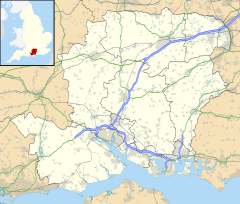Neatham
Neatham is a Roman hamlet, an ancient hundred and a former civil parish, now in the parish of Alton, in the East Hampshire district of Hampshire, England. Its nearest town is Alton, which lies 1.6 miles (2.6 km) south-west from the hamlet. In 1931 the parish had a population of 134.[1]
History
[edit]Roman period – Vindomis
[edit]The lost Roman settlement of Vindomis is believed to be at Neatham. Its strategic importance lay in its being at the crossing of important roads: one from Winchester towards London and the other from Chichester to Silchester, a large Roman town to the north of present-day Basingstoke. The name Vindomis might be translated as ‘(The mansio) of the wine country’ (although this may equally be a Celtic name, with the prefix VINDO-'white'). Vindomis may well have been the administrative centre of a large estate associated with the potteries.[2] The population at this time is estimated to have been 2,500.
Neatham was formerly a tything in the parish of Holybourne.[3] From 1866 Neatham was a civil parish in its own right; on 1 April 1932 the parish was abolished and merged with Alton and Binsted.[4]
Saxon period – Neatham
[edit]After the Romans left, it became a Saxon settlement, called Neatham, indicating the presence of a cattle market. For several centuries, Neatham remained the chief place in the area and the focal point of Neatham Hundred, which included a large part of north-east Hampshire.
Norman period
[edit]At the time of the Domesday Book in 1085, Neatham was recorded as a hundred belonging to the Crown comprising 96 households.[5] Neatham Hundred included 24 other places.[6] After the founding of Waverley Abbey in 1128, King Steven made a gift of Neatham for the Abbey to establish a Grange and an Oratory, with a community of 12 monks, independent of the parish of Holybourne. Eventually, Neatham was eclipsed by Alton and, in the 12th century, the area was renamed the Alton Hundred.
Tudor period
[edit]When Henry VIII dissolved the monasteries, Neatham went into lay hands and became part of the parish of Binsted.
Modern day
[edit]In the 1980s, Neatham elected to be joined to Holybourne. Neatham is now a hamlet comprising a Manor House, a Grange, a mill, and a dozen cottages. Today, the hamlet lies along the Alton bypass between Alton and Farnham. Its Grade I buildings and mills still remain.
Notable buildings
[edit]- Neatham Grange
- Mill House (C.19)[7]
- Upper Neatham Mill
- Neatham Mill
- Neatham Manor
References
[edit]- ^ "Population statistics Neatham Tg/CP through time". A Vision of Britain through Time. Retrieved 20 May 2023.
- ^ The distribution of Alice Holt/Farnham ware pp57–58 Original PDF
- ^ "History of Neatham in East Hampshire". A Vision of Britain through Time. Retrieved 20 May 2023.
- ^ "Relationships and changes Neatham Tg/CP through time". A Vision of Britain through Time. Retrieved 20 May 2023.
- ^ Hampshire Treasures Volume 6 (East Hampshire) Page 47 - Binsted
- ^ "Open Domesday: Hundred of Neatham". Retrieved 22 August 2021.
- ^ a b c d Hampshire Treasures Volume 6 (East Hampshire) p49
- ^ a b "Hampshire Treasures Volume 6 (East Hampshire) p48". Archived from the original on 5 June 2011. Retrieved 6 October 2009.
- ^ Hampshire Treasures Volume 6 (East Hampshire) p50



